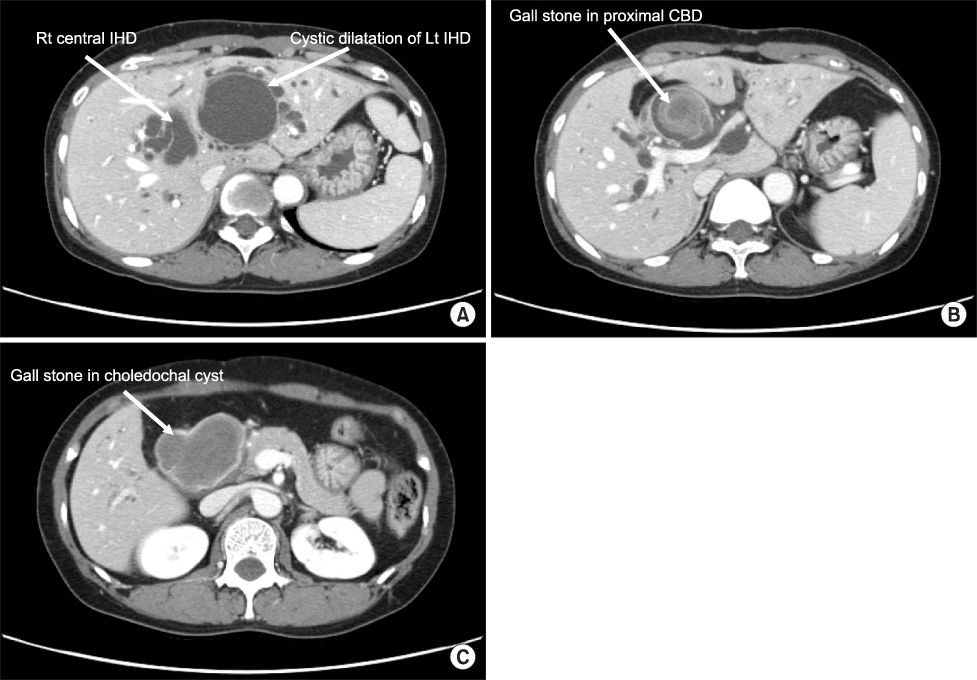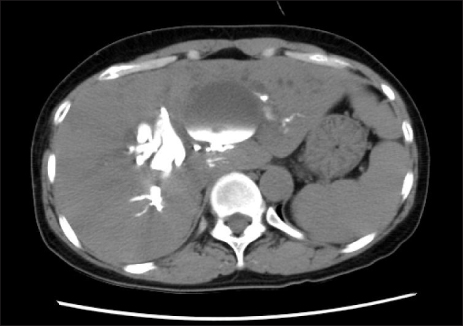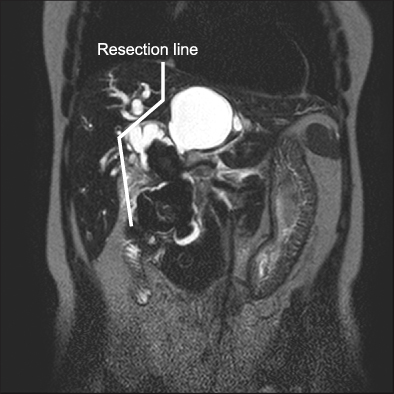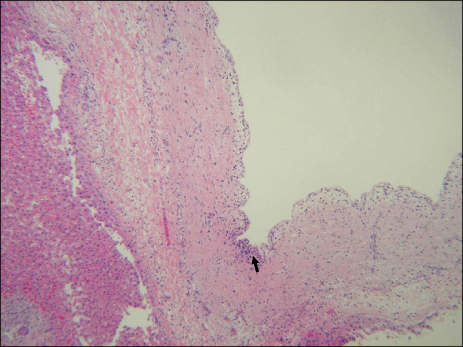J Korean Surg Soc.
2010 Feb;78(2):123-126. 10.4174/jkss.2010.78.2.123.
Type IV-A Choledochal Cyst with Intrahepatic Bile Duct Stricture
- Affiliations
-
- 1Department of Surgery, Kangwon National University Hospital, Chuncheon, Korea. skhong@knuh.or.kr
- KMID: 2096567
- DOI: http://doi.org/10.4174/jkss.2010.78.2.123
Abstract
- Choledochal cysts are rare congenital anomalies of the bile ducts. They consist of cystic dilatations of the extrahepatic biliary tree, intrahepatic radicles, or both. The standard treatment of choledochal cyst is complete excision of cyst and drainage procedure. I report a case of 48-year-old women who was diagnosed with type IV-A choledochal cyst with intrahepatic bile duct stricture and large stones in extrahepatic choledochal cyst. Sixteen years ago, she received a cholecystectomy and Reux-en Y cystojejunostomy due to choledochal cyst. Because of the intrahepatic bile duct stricture I performed a left hepatectomy, complete cyst excision and hepaticojejunostomy. I report this case with a review of the literature.
Keyword
MeSH Terms
Figure
Reference
-
1. Yamaguchi M. Congenital choledochal cyst. Analysis of 1,433 patients in the Japanese literature. Am J Surg. 1980. 140:653–657.2. Miyano T, Yamataka A. Choledochal cysts. Curr Opin Pediatr. 1997. 9:283–288.3. Babbitt DP. Congenital choledochal cysts: new etiological concept based on anomalous relationships of the common bile duct and pancreatic bulb. Ann Radiol (Paris). 1969. 12:231–240.4. Todani T, Watanabe Y, Fujii T, Uemura S. Anomalous arrangement of the pancreatobiliary ductal system in patients with a choledochal cyst. Am J Surg. 1984. 147:672–676.5. Mori K, Nagakawa T, Ohta T, Nakano T, Kayahara M, Akiyama T, et al. Pancreatitis and anomalous union of the pancreaticobiliary ductal system in childhood. J Pediatr Surg. 1993. 28:67–71.6. Todani T, Watanabe Y, Narusue M, Tabuchi K, Okajima K. Congenital bile duct cysts: Classification, operative procedures, and review of thirty-seven cases including cancer arising from choledochal cyst. Am J Surg. 1977. 134:263–269.7. Park Y, Kim SW, Lee KU, Suh KS. Hepato-Biliary-Pancreatic Surgery. 2000. Seoul: Medrang Publishing.8. Nakayama H, Masuda H, Ugajin W, Koshinaga T, Fukuzawa M. Left hepatic lobectomy for type IV-A choledochal cyst. Am Surg. 2000. 66:1020–1022.9. Flanigan PD. Biliary cysts. Ann Surg. 1975. 182:635–643.10. Reveille RM, Van Stiegmann G, Everson GT. Increased secondary bile acids in a choledochal cyst. Possible role in biliary metaplasia and carcinoma. Gastroenterology. 1990. 99:525–527.
- Full Text Links
- Actions
-
Cited
- CITED
-
- Close
- Share
- Similar articles
-
- Type IVB Choledochal Cyst : A case report
- A Case Report of an Unusual Type of Choledochal Cyst with Choledocholithiasis: Saccular Dilatation of the Confluent Portion of Both Intrahepatic Ducts
- Postoperative Change of Intrahepatic Bile Duct Dilatation in Choledochal Cyst
- Long-term complications after extrahepatic cyst excision for type IV-A choledochal cysts
- A Case of Intrahepatic Cholangiocarcinoma Associated with Type IV Choledochal Cyst






